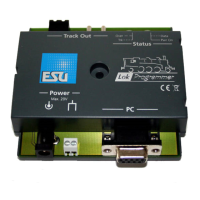
Do you have a question about the Esu LokProgrammer and is the answer not in the manual?
| Interface | USB |
|---|---|
| Type | Decoder programmer |
| Compatibility | ESU decoders |
| Software | LokProgrammer software |
| Power Supply | USB |
| Supported Protocols | DCC, Motorola, M4 |
| Function | Decoder programming, sound file upload |
| Operating System | Windows, MacOS |
Information on disposal of electrical and electronic equipment and batteries.
Lists the necessary hardware and software for the LokProgrammer.
Guides through connecting the LokProgrammer and installing the software.
Describes how to launch the installed LokProgrammer software.
Explains how to download and install software and firmware updates.
Explains how LokSound decoders reproduce various locomotive sounds.
Describes the specific sounds and characteristics of steam locomotives.
Details the sounds and operational characteristics of diesel-electric locomotives.
Explains the sound characteristics of diesel-hydraulic locomotives.
Details the sound types and characteristics of electric locomotives.
Discusses compatibility with DCC, Motorola®, M4, and Selectrix® protocols.
Explains the purpose and application of Configuration Variables (CVs).
Provides additional details on LokSound decoders, including speaker connection.
Details on preparing sound files for optimal quality and memory usage.
Lists the ESU decoder models and software versions supported by the LokProgrammer.
Explains the software's purpose, features, and the assistant feature.
Explains the different registers and menus within the LokProgrammer software interface.
Details the functions available in the task bar and toolbar for managing projects.
Explains how to use the virtual driver's cab for testing locomotives and functions.
Guides on reading and writing individual Configuration Variables (CVs).
Details the decoder register for adjusting motor control and driving characteristics.
Details setting short and long addresses for locomotives.
How to adjust locomotive driving behavior, including speed steps.
Setting speed steps, reverse mode, acceleration, and deceleration.
Adjusting sound behavior and parameters like volume and random sounds.
Selecting sound types and adjusting overall and group sound volumes.
Configuring load compensation, steam shift, and brake sound thresholds.
Allocating sounds and functions to specific buttons on the command station.
Configuring headlights, AUX outputs, and diesel acceleration/coasting.
Controlling shunting mode, sound on/off, Doppler effect, and volume.
Configuring outputs, LGB mode, Märklin delta mode, and function behavior.
Directly entering and saving Configuration Variables (CVs).
Pre-selecting options for power interruptions and device identification.
Explains the LokSound sound module's memory and loop playback concept.
How to import and manage sound files within a project.
Assigning sound fragments to specific sound slots.
Using additional tools for sound configuration like setting locomotive type.
Outlines rules and possibilities for composing sounds using schedules.
Explains the schedule for driving sounds based on locomotive states.
Describes the schedule specific to fan sounds, common in electric locomotives.
Defines thresholds for changing sounds based on speed and speed differences.
How to set up the sound schedule and parameters.
Detailed view and configuration of individual sound slots.
Adjusting sound slot properties like loop mode, volume, and speed adaptation.
Configuring and importing random sounds for ambient effects.
General settings for user sounds, including priority and time delays.
Special configurations for specific user sound slots.
Using alternative sounds triggered by the "Shift" function.
Overview of M4-specific settings differing from DCC.
Setting locomotive symbols, names, and configuring M4 protocols.
Configuring M4 motor, sound, and function output settings.
Provides a short overview of settings for LokSound micro and XL models.
Instructions for creating a new project file for a steam locomotive.
Configuring general settings for the steam locomotive project.
Importing and arranging sound files for the steam locomotive project.
Mapping functions to buttons for the steam locomotive project.
Adjusting exhaust chuff timing for steam locomotive realism.
Fine-tuning sounds and volumes after project setup.
Guide to creating a sound project for a diesel-electric locomotive.
Creating new project files and configuring general settings for diesel locomotives.
Importing and arranging sound files for a diesel-electric locomotive.
Mapping functions and fine-tuning sounds for diesel-electric projects.
Creating new project files and configuring general settings for diesel-hydraulic locomotives.
Importing and arranging sound files for diesel-hydraulic/manual locomotives.
Mapping functions and fine-tuning sounds for diesel-hydraulic/manual locomotives.
Guide to creating a sound project for an electric locomotive.
Creating new project files and configuring general settings for electric locomotives.
Importing and arranging sound files for the electric locomotive.
Miscellaneous information, including Doppler effect and hardware details.
How to activate the Doppler effect during operation.
Solutions for issues encountered when reading decoder data.
Information on memory types and customer support resources.
A comprehensive list of all Configuration Variables (CVs) and their functions.
Details the terms of the license agreement and prohibited uses.
Outlines IP rights, agreement duration, and termination conditions.
Disclaims warranties and limits ESU's liability concerning the content.
Section for filling out goods return information for warranty claims.
Provides warranty details, conditions, and exemptions for ESU products.